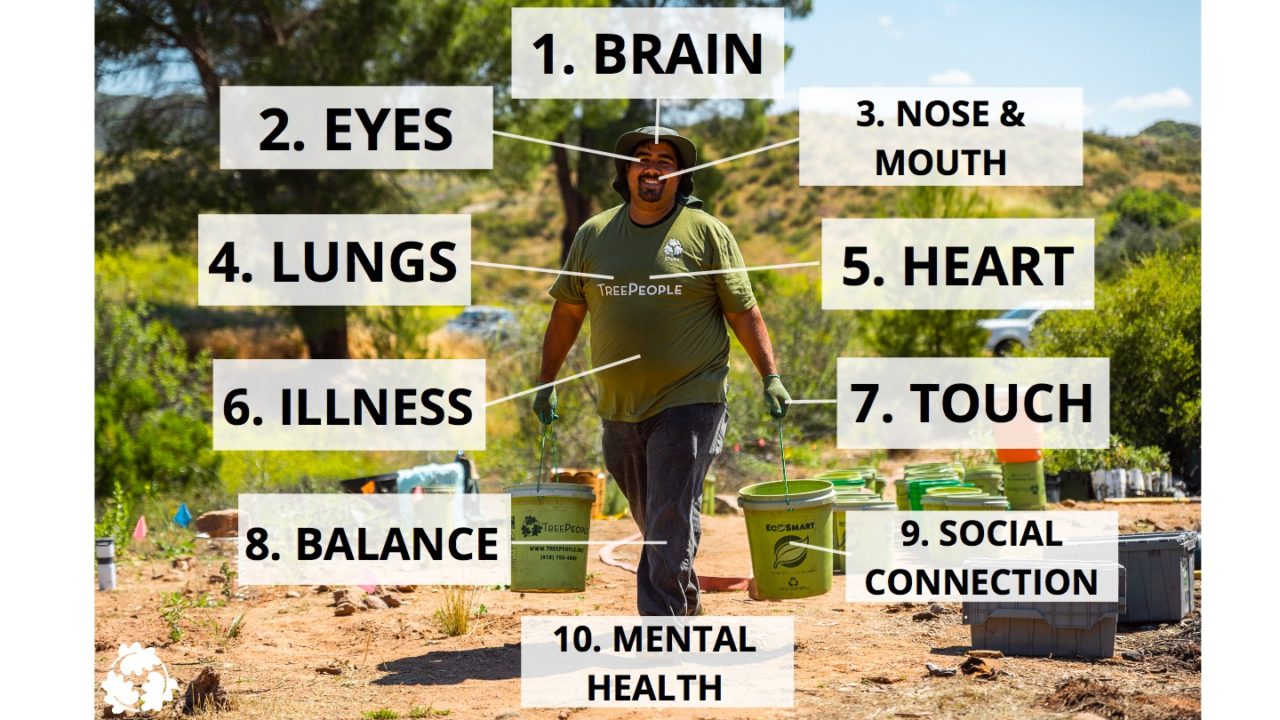
Written by Carissa Donahoo, Public/Mental Health Organizer
Did you know trees and nature have the power to heal us from head to toe?
That is why it is always important — especially now — that we get outside and explore our urban forests, or just our backyards, patios, or even just looking out a window.
Here are a few of the ways the nature in your own community can help out your body:
- Starting at the top of your head with your brain, researchers have found being outside around nature and trees helps to calm and renew your brain’s thoughts, improving your ability to focus!
- Pro Tip: When you find yourself stressed out, go outside and notice the types of plants and animals you see. Do any trees live around you? Stay outside for ten to fifteen minutes and notice how your mind feels after!
- Looking at the trees through your eyes can help your vision! People who spend more time outdoors are not as likely to need glasses for nearsightedness. Scientists have also found children who spend more than 2 hours a day outdoors are three times less likely to need glasses.
- Pro Tip: Go outside and look up into the branches of your favorite tree and see if you can find any critters that made a home in them. How many critters can you find?
- Taking a deep breath through your nose or mouth, what do you smell? Researchers have found outdoor activities can develop one’s taste and smell with different types of scents. Taste and smell work closely together, and the outdoors has a wider variety of aromas than the indoors!
- Pro Tip: Go into your garden or for a stroll around your neighborhood and count the different things you smell – from manure and soil to flowers and trees. How many smells are there?
- Speaking of smells, that air goes into our lungs. We know that trees clean the air by absorbing carbon dioxide and producing oxygen, but did you know this lowers the rates of asthma? Researchers have found communities with more trees have lower hospitalizations due to asthma!
- Pro Tip: Try out a breathing exercise. (Bonus if you do it outside!) Draw your elbows back to allow your chest to expand, take a deep inhale through your nose for five seconds, hold for three seconds, then slowly release through your mouth! What did you feel?
- Do you wear your heart on your sleeve? Studies show that nature and trees positively impact blood pressure and cholesterol, lowers heart rate, and reduces the stress hormone cortisol!
- Pro Tip: If you can’t go outside, try looking at pictures or videos of nature – this is almost as good as the real thing for your heart! Do you notice a difference?
- Trees and nature help with illness too! Researchers know that patients with views of natural settings from their hospital windows heal faster with less complications and take fewer pain medications than those who have no view.
- Pro Tip: Can you see a tree, park, shrub, or other plants from your window? If so, take time out of your day to look at it! If you don’t see any, try getting your very own house plant! You can even name and talk to them like a friend! What are your plants’ names?
- When was the last time you touched a plant? Researchers have found that children who play outdoors are more tolerating of different textures than those who play solely inside.
- Pro Tip: If you have a garden or plants, try touching the soil your plants live in or touching the plants themselves. What do they feel like?
- Note: due to COVID-19, TreePeople is not encouraging others to touch plants in public places.
- If you’re outside, sometimes you can lose your balance, but did you know that being outdoors on varying surfaces and playing in trees challenges different muscles, making you more stable?
- Pro Tip: The next time you go outside, try going on different surfaces: dirt, grass, sidewalk, whatever is in your urban forest. Is your body shifting in different ways based on the surface?
- Times are pretty isolating right now, but nature and trees can help with social connection. Natural areas have the ability to increase socialization and make people feel less lonely.
- Pro Tip: Get outside if you’re feeling lonely and interact with nature in your urban forest! What types of plants and animals do you meet?
- Above all else, nature and trees can help out with mental health. As minimal as five hours a month (two 40-minute sessions per week) in your urban forest can help to prevent mild depression.
- Pro Tip: Explore your urban forest and discover what lives around you! Let us know what you found!!
